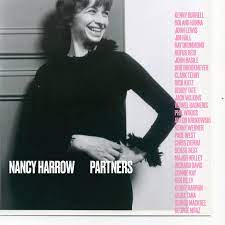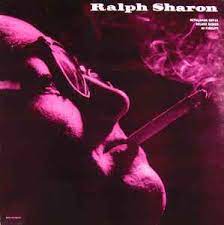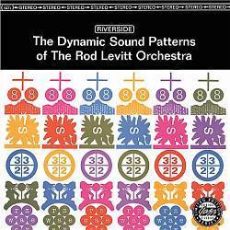
Daily Dose Of Jazz…
Nancy Harrow was born October 3, 1930 in New York City, New York and studied classical piano beginning at age seven, then decided to pursue careers in dancing and singing.
In 1961 Nancy released her debut album Wild Women Don’t Have The Blues for Candid Records. It featured Kenny Burrell, Buck Clayton, Dickie Wells, and Milt Hinton. Her sophpomore album for Atlantic Records two years later titled You Never Know featured John Lewis, Dick Katz, Phil Woods, Jim Hall, Richard Davis, and Connie Kay. She then left music to raise a family.
Since her return in 1975 she has worked with Katz and Woods, Clark Terry, Roland Hanna, and Bob Brookmeyer. She recorded albums based on The Lost Lady by Willa Cather, The Marble Faun by Nathaniel Hawthorne and Winter Dreams, based on the life of F. Scott Fitzgerald.
Two of Harrow’s songs have been adapted, one to a puppet show and one to The Cat Who Went to Heaven, based on a story by Elizabeth Coatsworth. The latter had short New York City runs at the Mercer Street Theater, the Asia Society, the Harlem School of the Arts, the Kennedy Center and the Brooklyn Academy of Music.
Singer and songwriter Nancy Harrow, who has recorded eighteen albums as a leader on a collaboration with John Lewis, continues to perform and record.
More Posts: composer,history,instrumental,jazz,music,piano,producer,vocal

Daily Dose Of Jazz…
Born on September 21, 1927 Ward Lamar Swingle grew up in Mobile, Alabama and studied music, particularly jazz, from a very young age. He learned clarinet, oboe and the piano as a child and played in Mobile-area big bands before he was out of high school. He continued his music studies at the Cincinnati Conservatory of Music, graduating summa cum laude in 1950.
Moving to France in 1951 on a Fulbright scholarship, he studied piano with Walter Gieseking and worked as a rehearsal pianist for Les Ballets de Paris. He met a French-born violin student, Françoise Demorest, and got married in 1952. 1959 saw Swingle as a founding member of Les Double Six of Paris, which specialised in scat singing of jazz standards.
This concept of scatting to Johann Sebastian Bach was the foundation for The Swingle Singers, which became fully established by 1962. They released their albums Jazz Sebastian Bach and Bach’s Greatest Hits in 1963 and their early recordings won five Grammy Awards. Disbanding the original Swingle Singers in 1973 he moved to London, England and formed a new group, and expanded their repertoire to include classical and avant-garde works along with the scat and jazz vocal arrangements.
Returning to live in America in 1984 he remained musical advisor for his London-based group, but devoted most of his time to workshops, guest conducting and the dissemination of his printed arrangements through his publishing company, Swingle Music. He went on to conduct several chamber and philharmonic choirs, and conduct workshops and seminars at universities in Europe and North America.
In 1994 he moved back to France, where he continued his work in arranging, composing and guest conducting. He wrote an autobiography and treatise titled Swingle Singing, in which he defined ‘Swingle Singing’ techniques with illustrations from his arrangements and compositions.
Vocalist, pianist and arranger Ward Swingle, who was named Officier de l’Ordre des Arts et des Lettres (Officer of the Order of Arts and Letters) by the French Minister of Culture and Information, transitioned in Eastbourne, England, on January 19, 2015.
More Posts: arranger,bandleader,history,instrumental,jazz,music,piano

Daily Dose Of Jazz…
Sir John Phillip William Dankworth was born on September 20, 1927 in Woodford, Essex, England. He grew up within a family of musicians and attended Selwyn Boys’ Junior School and later Sir George Monoux Grammar School. Prompted by hearing a Benny Goodman Quartet album at 16, before settling on the clarinet he took violin and piano lessons. Soon afterwards he was inspired by Charlie Parker and learned to play the alto saxophone.
Beginning his career on the British jazz scene after studying at London’s Royal Academy of Music and then national service in the Royal Air Force, during which he played alto sax and clarinet for RAF Music Services. By 1947 he was working on the Queen Mary in Bobby Kevin’s band, and in London with Les Ayling. Through the rest of the decade he performed with Tito Burns, with Charlie Parker at the Paris Jazz Festival, and a tour of Sweden with Sidney Bechet. In 1949, Johnny was voted Musician of the Year.
The Fifties saw him forming a small group, the Dankworth Seven, as a vehicle to showcase his writing as well as several young players, Jimmy Deuchar, Eddie Harvey, Don Rendell, Bill Le Sage, Eric Dawson, Tony Kinsey and Frank Holder. also sang and recorded with this ensemble. Forming his big band in ‘53 and Cleo Laine was now a regular voice on appearances and recordings.
The band came to the States and performed at Newport, Birdland had Louis Armstrong sit in for a set and shared several stages with the Duke Ellington Orchestra. In 1959, John became chair of the Stars Campaign for Inter-Racial Friendship, set up to combat the fascist White Defence League.
The following decades saw him working and recording with numerous American and British jazz musicians, began composing for film and television, and received commissions all while performing live and on the radio.
As an educator his enthusiasm for jazz education led him to run for many years the Allmusic summer schools at the Stables in Wavendon and from 1984 to ‘86 he was a professor of music at Gresham College in London, where he gave free public lectures.
He was awarded an Honorary Doctorate of Music from Berklee College of Music, was made a Knight Bachelor in the 2006 New Year’s Honours List, and was made a Commander of the British Empire (CBE). In 2009 he fell ill and while he had to cancel several concerts he made one last appearance in December.
Saxophonist, clarinetist, composer, educator John Dankworth, who along with his wife Dame Cleo were one of a few couples to hold British titles, transitioned on February 6, 2010 at the age of 82, on the afternoon before a show celebrating the 40th anniversary of the foundation of The Stables.
Confer a dose of a Woodford saxophonist to those seeking a greater insight about the musicians around the world who are members of the pantheon of jazz…
More Posts: bandleader,clarinet,composer,educator,history,instrumental,jazz,music,music director,saxophone

Daily Dose Of Jazz…
Ralph Simon Sharon was born in London, England on September 17, 1923 to a British mother and Latvian-born father. He emigrated to the United States in early 1954 and became a naturalized citizen five years later.
By 1958, Ralph was recording with Tony Bennett as accompanist. That was the start of a more than 50 year working relationship. He found the song I Left My Heart in San Francisco for Bennett, which became his signature song.
A jazz pianist in his own right, Sharon recorded nineteen albums as a leader, 15 with Bennett and two with Johnny Hartman. However, he also accompanied the likes of Robert Goulet, Chris Connor and nemerous others. Retiring to Boulder, Colorado, from on-the-road work when he reached 80, he continued to perform in the Denver metropolitan area until shortly before his death.
Pianist and arranger Ralph Sharon, best known as one of the finest accompanists who backed up popular singers, transitioned from natural causes on March 31, 2015.
More Posts: arranger,bandleader,history,instrumental,jazz,music

Daily Dose Of Jazz…
Rodney Charles Levitt was born on September 16, 1929 in Portland, Oregon and studied composition at the University of Washington, where he took his BA in 1951.
He was in the Radio City Music Hall orchestra from 1957 to 1963, and during those years he performed with Dizzy Gillespie, Ernie Wilkins, Kai Winding, and Sy Oliver. In 1959 Rod worked with Gil Evans when his orchestra accompanied Miles Davis. The following year he played with Gerry Mulligan and Mundell Lowe, with Quincy Jones in ‘61, and with Oliver Nelson in 1962.
He recorded four albums as a leader of an octet between 1963-66 and continued to work with this combination into the 1970s, when he played with bassist Chuck Israels.
Later in his career he worked with Cedar Walton and Blue Mitchell, and wrote music for commercials with a company he ran from 1966-1989. The late Seventies saw him teaching at Fairleigh Dickinson, Hofstra University, CUNY, and Hunter College.
Trombonist, composer, and bandleader Rod Levitt transitioned from Alzheimer’s disease in Wardsboro, Vermont at the age of 77 on May 8, 2007.
More Posts: bandleader,composer,history,instrumental,jazz,music,trombone



